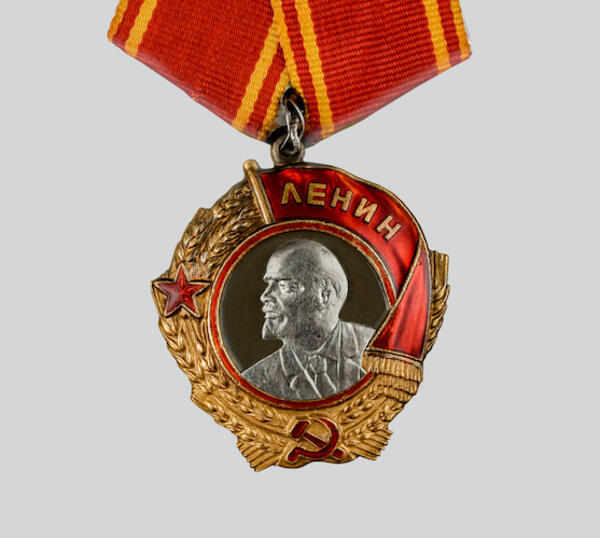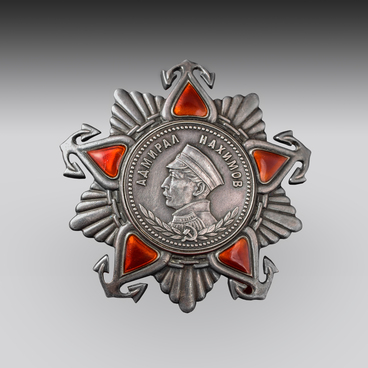This Order of Lenin belongs to Fyodor Kostin, the Soviet Union Hero. He fought on the Western Front and especially distinguished himself in the battles for the Liberation of the Baltic States. Kostin and his unit were one of the first who crossed the State Border of the USSR with Lithuania. He was awarded the title the Hero of the Soviet Union for the courage and heroism shown in the battles on March 24, 1945.
The history of the order began on July 8, 1926, when the head of the Main Directorate of the Workers' and Peasants' Red Army, Vasily Levichev, proposed to issue a new award, the ‘Order of Ilyich’, to persons who already had four orders of the Red Banner. This award was supposed to be the highest military distinction. However, at that time, the combat operations of the Civil War had already ended, so the draft of the new order was not accepted.
At the same time, the Council of People’s Commissars of the USSR decided to create the highest award of the Soviet Union, awarded not only for military merit. At the beginning of 1930, work resumed on the project of a new order, called the Order of Lenin. The artists of the ‘Goznak’ factory in Moscow were given the task to create a drawing of the order, the main image on which was to be a portrait of Lenin. They chose the work of the artist Ivan Dubasov from a variety of sketches. He took as the basis of the portrait a photograph of Lenin, which was taken by photographer Viktor Bulla at the Second Congress of the Comintern in 1920.
In the spring of 1930, the sketch of the order was given to sculptors Ivan Shadr and Peter Taiga to create a layout. In the same year, the first Orders of Lenin were issued at the Goznak factory. The award was established by the decree of the Presidium of the CEC of the USSR on April 6, 1940.
The order’s design, dimensions and materials have changed many times both during the creation process and after its establishment. Initially, the composition, except the wreath of ears framing the central round medallion, sickle, and hammer, the letters ‘USSR’, also included a triangle in the lower part of the order. It symbolized the ‘triple’ union of workers, the working peasantry and the intellectuals. However, this design was not approved.
The description of the Order of Lenin from the statute of the last edition of March 28, 1980, states:
The history of the order began on July 8, 1926, when the head of the Main Directorate of the Workers' and Peasants' Red Army, Vasily Levichev, proposed to issue a new award, the ‘Order of Ilyich’, to persons who already had four orders of the Red Banner. This award was supposed to be the highest military distinction. However, at that time, the combat operations of the Civil War had already ended, so the draft of the new order was not accepted.
At the same time, the Council of People’s Commissars of the USSR decided to create the highest award of the Soviet Union, awarded not only for military merit. At the beginning of 1930, work resumed on the project of a new order, called the Order of Lenin. The artists of the ‘Goznak’ factory in Moscow were given the task to create a drawing of the order, the main image on which was to be a portrait of Lenin. They chose the work of the artist Ivan Dubasov from a variety of sketches. He took as the basis of the portrait a photograph of Lenin, which was taken by photographer Viktor Bulla at the Second Congress of the Comintern in 1920.
In the spring of 1930, the sketch of the order was given to sculptors Ivan Shadr and Peter Taiga to create a layout. In the same year, the first Orders of Lenin were issued at the Goznak factory. The award was established by the decree of the Presidium of the CEC of the USSR on April 6, 1940.
The order’s design, dimensions and materials have changed many times both during the creation process and after its establishment. Initially, the composition, except the wreath of ears framing the central round medallion, sickle, and hammer, the letters ‘USSR’, also included a triangle in the lower part of the order. It symbolized the ‘triple’ union of workers, the working peasantry and the intellectuals. However, this design was not approved.
The description of the Order of Lenin from the statute of the last edition of March 28, 1980, states:



